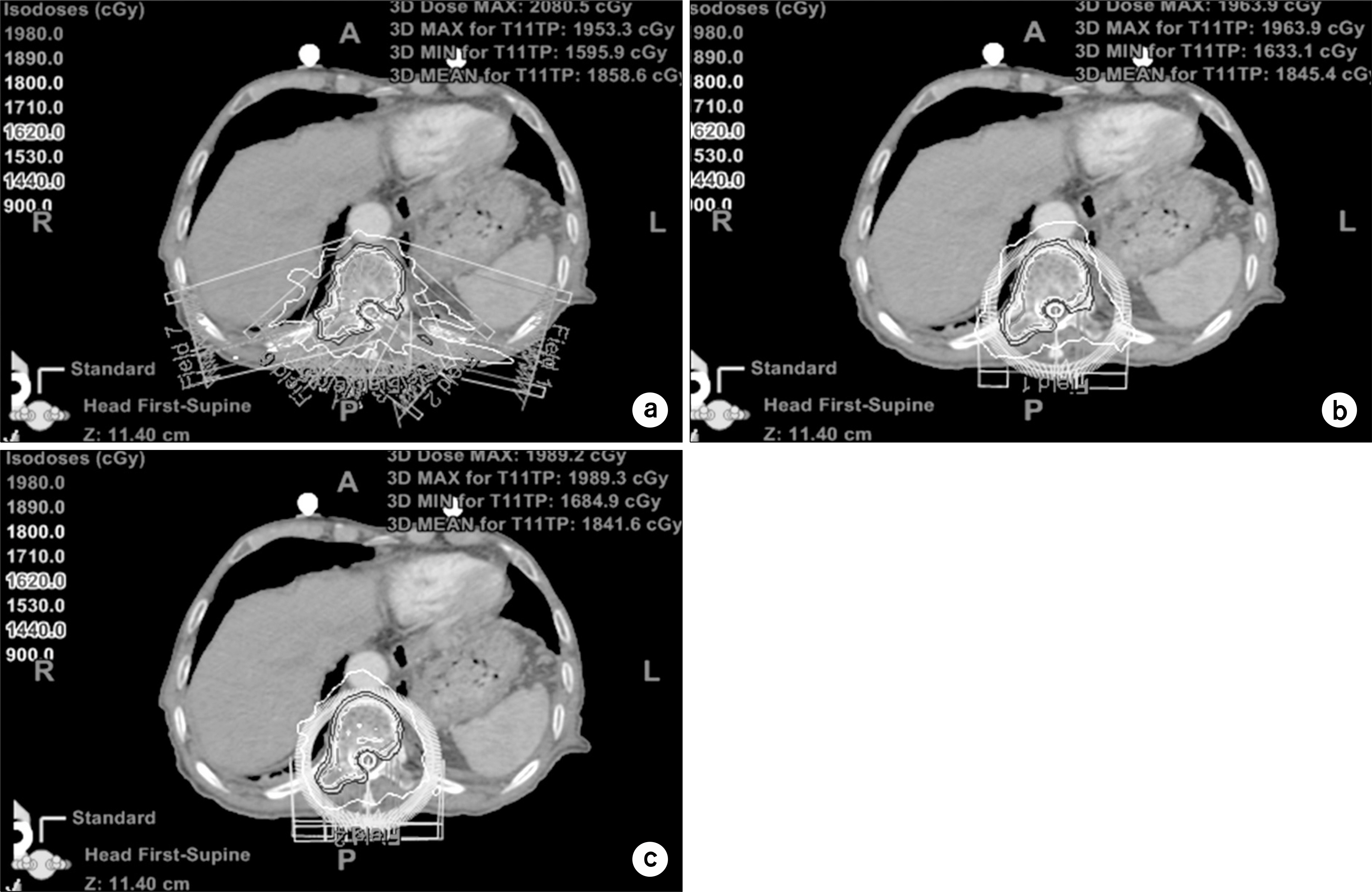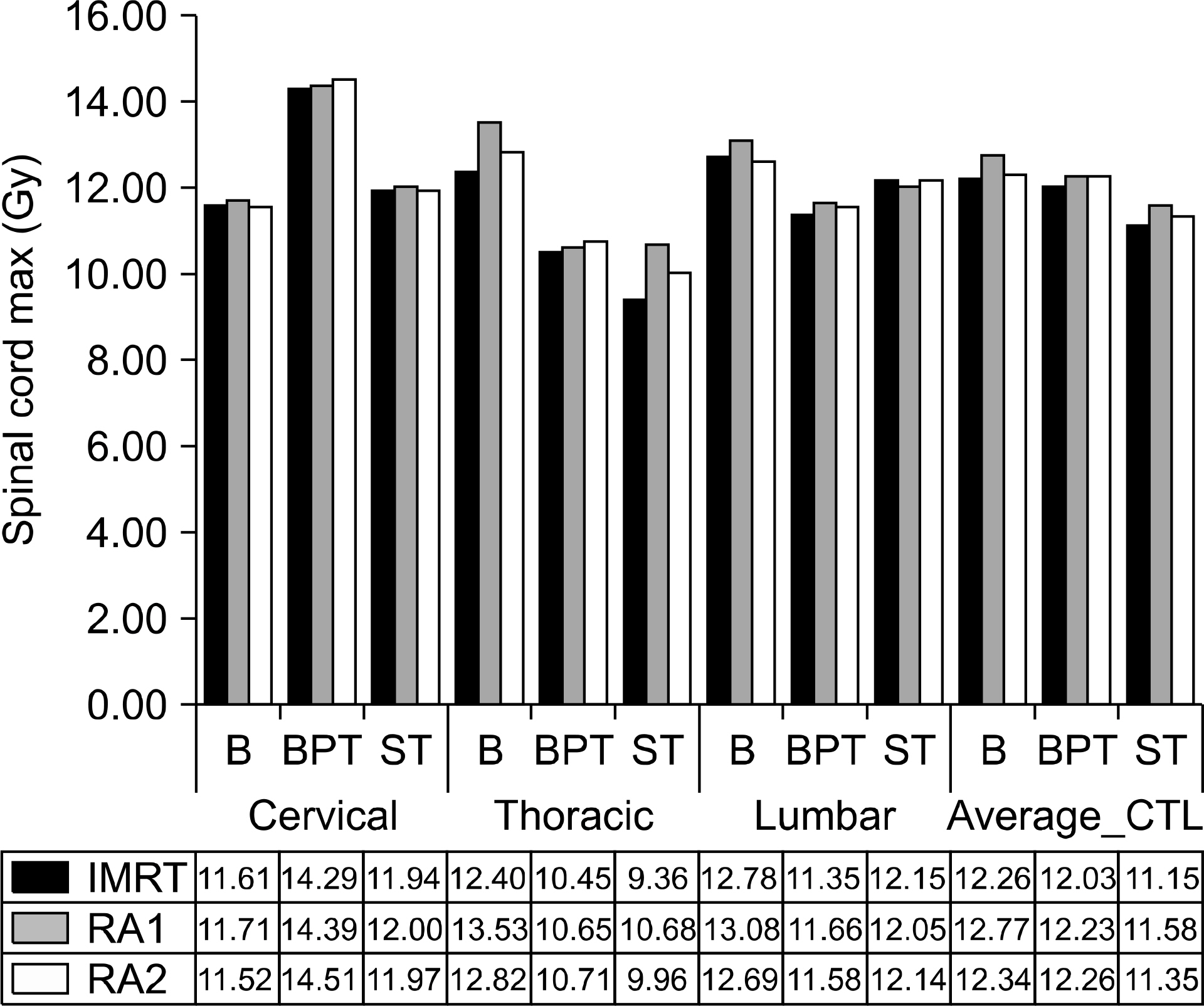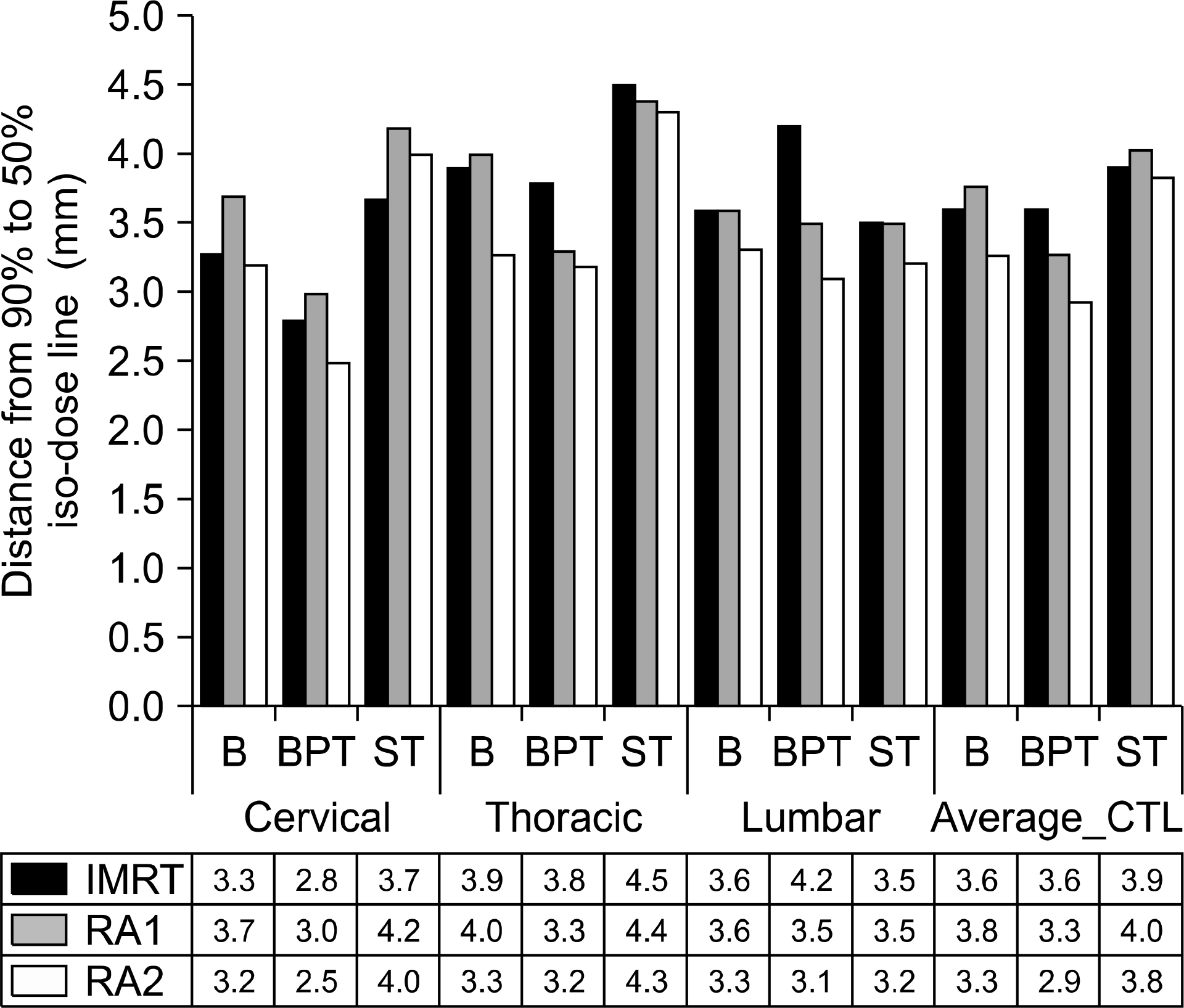Comparison of IMRT and VMAT Techniques in Spine Stereotactic Radiosurgery with International Spine Radiosurgery Consortium Consensus Guidelines
- Affiliations
-
- 1Department of Radiation Oncology, Yeungnam University Medical Center, Daegu, Korea.
- 2Department of Physics, Yeungnam University, Gyeongsan, Korea.
- 3Department of Radiation Oncology, Yeungnam University College of Medicine, Daegu, Korea. yjw1160@ynu.ac.kr
- KMID: 1910578
- DOI: http://doi.org/10.14316/pmp.2013.24.3.145
Abstract
- Stereotactic body radiation therapy (SBRT) is increasingly used to treat spinal metastases. To achieve the highest steep dose gradients and conformal dose distributions of target tumors, intensity-modulated radiation therapy (IMRT) and volumetric-modulated arc therapy (VMAT) techniques are essential to spine radiosurgery. The purpose of the study was to qualitatively compare IMRT and VMAT techniques with International Spine Radiosurgery Consortium (ISRC) contoured consensus guidelines for target volume definition. Planning target volume (PTV) was categorized as T(B), T(BPT) and T(ST) depending on sectors involved; T(B) (vertebral body only), T(BPT) (vertebral body+pedicle+transverse process), and T(ST) (spinous process+transverse process). Three patients treated for spinal tumor in the cervical, thoracic, and lumbar region were selected. Each tumor was contoured by the definition from the ISRC guideline. Maximum spinal cord dose were 12.46 Gy, 12.17 Gy and 11.36 Gy for T(B), T(BPT) and T(ST) sites, and 11.81 Gy, 12.19 Gy and 11.99 Gy for the IMRT, RA1 and RA2 techniques, respectively. Average fall-off dose distance from 90% to 50% isodose line for T(B), T(BPT), and T(ST) sites were 3.5 mm, 3.3 mm and 3.9 mm and 3.7 mm, 3.7 mm and 3.3 mm for the IMRT, RA1 and RA2 techniques, respectively. For the most complicated target T(BPT) sites in the cervical, thoracic and lumbar regions, the conformity index of the IMRT, RA1 and RA2 is 0.621, 0.761 and 0.817 and 0.755, 0.796 and 0.824 for rDHI. Both IMRT and VMAT techniques delivered high conformal dose distributions in spine stereotactic radiosurgery. However, if the target volume includes the vertebral body, pedicle, and transverse process, IMRT planning resulted in insufficient conformity index, compared to VMAT planning. Nevertheless, IMRT technique was more effective in reducing the maximum spinal cord dose compared to RA1 and RA2 techniques at most sites.
Keyword
MeSH Terms
Figure
Cited by 3 articles
-
A Comparison between Portal Dosimetry and Mobius3D Results for Patient-Specific Quality Assurance in Radiotherapy
Sung Yeop Kim, Jaehyeon Park, Jae Won Park, Ji Woon Yea, Se An Oh
Prog Med Phys. 2021;32(4):107-115. doi: 10.14316/pmp.2021.32.4.107.Fabrication of a Patient-Customized Helmet with a Three-Dimensional Printer for Radiation Therapy of Scalp
Se An Oh, Chang Min Lee, Min Woo Lee, Yeong Seok Lee, Gyu Hwan Lee, Seong Hoon Kim, Sung Kyu Kim, Jae Won Park, Ji Woon Yea
Prog Med Phys. 2017;28(3):100-105. doi: 10.14316/pmp.2017.28.3.100.Comparison of the Dose Distributions with Beam Arrangements in the Stereotactic Body Radiotherapy (SBRT) for Primary Lung Cancer
Ji Woon Yea
Prog Med Phys. 2014;25(2):110-115. doi: 10.14316/pmp.2014.25.2.110.
Reference
-
1. Benedict SH, Yenice KM, Followill D, et al. AAPM Radiation Therapy Committee Task Group 101: stereotactic body radiation therapy. Med Phys. 37:4078–4101. 2010.2. Matuszak MM, Yan D, Grills I, Martinez A. Clinical applications of volumetric modulated arc therapy. Int J Radiat Oncol Biol Phys. 77:608–616. 2010.
Article3. Sahgal A, Larson DA, Chang EL. Stereotactic body radiosurgery for spinal metastases: a critical review. Int Radiat Oncol Biol Phys. 71:652–665. 2008.
Article4. Ingrid TK, Max D, Suresh S, Wilko FV. Volumetric modulated arc therapy versus conventional intensity modulated radiation therapy for stereotactic spine radiotherapy: A planning study and early clinical data. Radiother Oncol. 94:224–228. 2010.5. Nelson JW, Yoo DS, Sampson JH, et al. Stereotactic body radiotherapy for lesions of the spine and paraspinal regions. Int Radiat Oncol Biol Phys. 73:1369–1375. 2009.
Article6. Wu QJ, Yoo S, Kirkpatrick JP, Thongphiew D, Yin FF. Volumetric arc intensity-modulated therapy for spine body radiotherapy: comparison with static intensity-modulated treatment. Int Radiat Oncol Biol Phys. 75:1596–1604. 2009.
Article7. Wang H, Shiu A, Wang C, et al. Dosimetric effect of translational and rotational error for patients undergoing image-guided stereotactic body radiotherapy for spinal metastases. Int Radiat Oncol Biol Phys. 71:1261–1271. 2008.8. Sahgal A, Ma L, Gibbs I, et al. Spinal cord tolerance for stereotactic body radiotherapy. Int Radiat Oncol Biol Phys. 77:548–553. 2010.9. Gutfeld O, Kretzler AE, Kashani R, Tatro D, Balter JM. Influence of rotations on dose distributions in spinal stereotactic body radiotherapy (SBRT). Int Radiat Oncol Biol Phys. 73:1596–1601. 2009.
Article10. Oh SA, Kang MK, Yea JW, Kim SK, Oh YK. Study of the penumbra for high-energy photon beams with GafchromicTM EBT2 films. J Korean Phys Soc. 60:1973–1976. 2012.11. Zacarias A, Brown MF, Mills MD. Volumetric modulated arc therapy (VMAT) treatment planning for superficial tumors. Med Dosi. 35:226–229. 2010.
Article12. Shaffer R, Nichol AM, Vollans E, et al. A comparison of volumetric modulated arc therapy and conventional intensitymodulated radiotherapy for frontal and temporal high-grade gliomas. Int Radiat Oncol Biol Phys. 76:1177–1184. 2010.
Article13. Daniela W, Hans C, Hendrik W, Hilke V. Radiotherapy of malignant gliomas: comparison of volumetric single arc technique (RapidArc), dynamic intensity-modulated technique and 3D conformal technique. Radiother Oncol. 93:593–596. 2009.14. Panet-Raymond V, Ansbacher W, Zavgorodni S, et al. Coplanar versus noncoplanar intensity-modulated radiation therapy (IMRT) and volumetric-modulated arc therapy (VMAT) treatment planning for fronto-temporal high-grade glioma. J Appl Clin Med Phys. 13:44–53. 2012.
Article15. Johnston M, Clifford S, Bromley R, Back M, Oliver L, Eade T. Volumetric-modulated arc therapy in head and neck radiotherapy: a planning comparison using simultaneous integrated boost for nasopharyx and oropharynx carcinoma. Clin Oncol. 23:503–511. 2011.16. Florian S, Dirk W, Heike S, Grit W, Frederik W, Frank L. A comparison of several modulated radiotherapy techniques for head and neck cancer and dosimetric validation of VMAT. Radiother Oncol. 101:388–393. 2011.17. Kumar SS, Vivekanandan N, Sriram P. A study on conventional IMRT and RapidArc treatment planning techniques for head and neck cancers. Rep Prac Oncol Radiother. 17:168–175. 2012.
Article18. Benthuysen LV, Hales L, Podgorsak MB. Volumetric modulated arc therapy VS. IMRT for the treatment of distal esophageal cancer. Med Dosi. 36:404–409. 2011.
Article19. Holt A, Vliet-Vroegindeweij C, Mans A, Belderbos JS, Damen EMFD. Volumetric-modulated arc therapy for stereotactic body radiotherapy of lung tumors: a comparison with intensity-modulated radiotherapy techniques. Int Radiat Oncol Biol Phys. 81:1560–1567. 2011.
Article20. Chin LO, Wilko FARV, Johan PC, Ben JS, Frank JL, Suresh S. Stereotactic radiotherapy for peripheral lung tumors: a comparison of volumetric modulated arc therapy with 3 other delivery techniques. Radiother Oncol. 97:437–442. 2010.21. Bree I, Hinsberg MGE, Veelen LR. High-dose radiotherapy in inoperable nonsmall cell lung cancer: comparison of volumetric modulated arc therapy, dynamic IMRT and 3D conformal radiotherapy. Med Dosi. 37:353–357. 2012.
Article22. Flemming KK, Lars O, Joakim M, Stine K. Rapidarc volumetric modulated therapy planning for prostate cancer patients. Acta Oncol. 48:227–232. 2009.23. Yoo S, Wu QJ, Lee WR, Yin FF. Radiotherapy treatment plans with rapidarc for prostate cancer involving seminal vesicles and lymph nodes. Int Radiat Oncol Biol Phys. 76:935–942. 2010.
Article24. Sze HCK, Lee MCH, Hung WM, Yau TK, Lee WM. Rapidarc radiotherapy planning for prostate cancer: single-arc and double-arc techniques vs. intensity-modulated radiotherapy. Med Dosi. 37:87–91. 2012.
Article25. Quan EM, Li X, Li Y, et al. A comprehensive comparison of IMRT and VMAT plan quality for prostate cancer treatment. Int Radiat Oncol Biol Phys. 83:1169–1178. 2011.
Article26. Cox BW, Spratt DE, Lovelock M, et al. International spine radiosurgery consortium consensus guidelines for target volume definition in spinal stereotactic radiosurgery. Int Radiat Oncol Biol Phys. 83:e597–e605. 2012.
Article27. Ryu S, Jin JY, Jin R, et al. Partial volume tolerance of the spinal cord and complications of single-dose radiosurgery. Cancer. 109:628–636. 2007.
Article28. Khan FM. The Physics of Radiation Therapy. 4th ed. Williams and Wilkins, Baltimore, MD. 2010.29. Oh SA, Kang MK, Yea JW, Kim SH, Kim KH, Kim SK. Comparison of intensity modulated radiation therapy dose calculations with a PBC and AAA algorithms in the lung cancer. Korean J Med Phys. 23:48–53. 2012.30. Feuvret L, Noel G, Mazeron JJ, Bey P. Conformity index: a review. Int Radiat Oncol Biol Phys. 64:333–342. (2006) 31. Mike O, Jeff C, Eugene W, Jake VD, Francisco P: A treatment planning study comparing whole breast radiation therapy against conformal, IMRT and tomotherapy for accelerated partial breast irradiation. Radiother Oncol 82: 317-323. 2007.
Article
- Full Text Links
- Actions
-
Cited
- CITED
-
- Close
- Share
- Similar articles
-
- The Role of Stereotactic Radiosurgery in Metastasis to the Spine
- Contemporary treatment with radiosurgery for spine metastasis and spinal cord compression in 2015
- The mixed era of stereotactic radiosurgery and radiotherapy
- Stereotactic radiosurgery for brain metastases
- Review of Stereotactic Radiosurgery for Intramedullary Spinal Lesions








